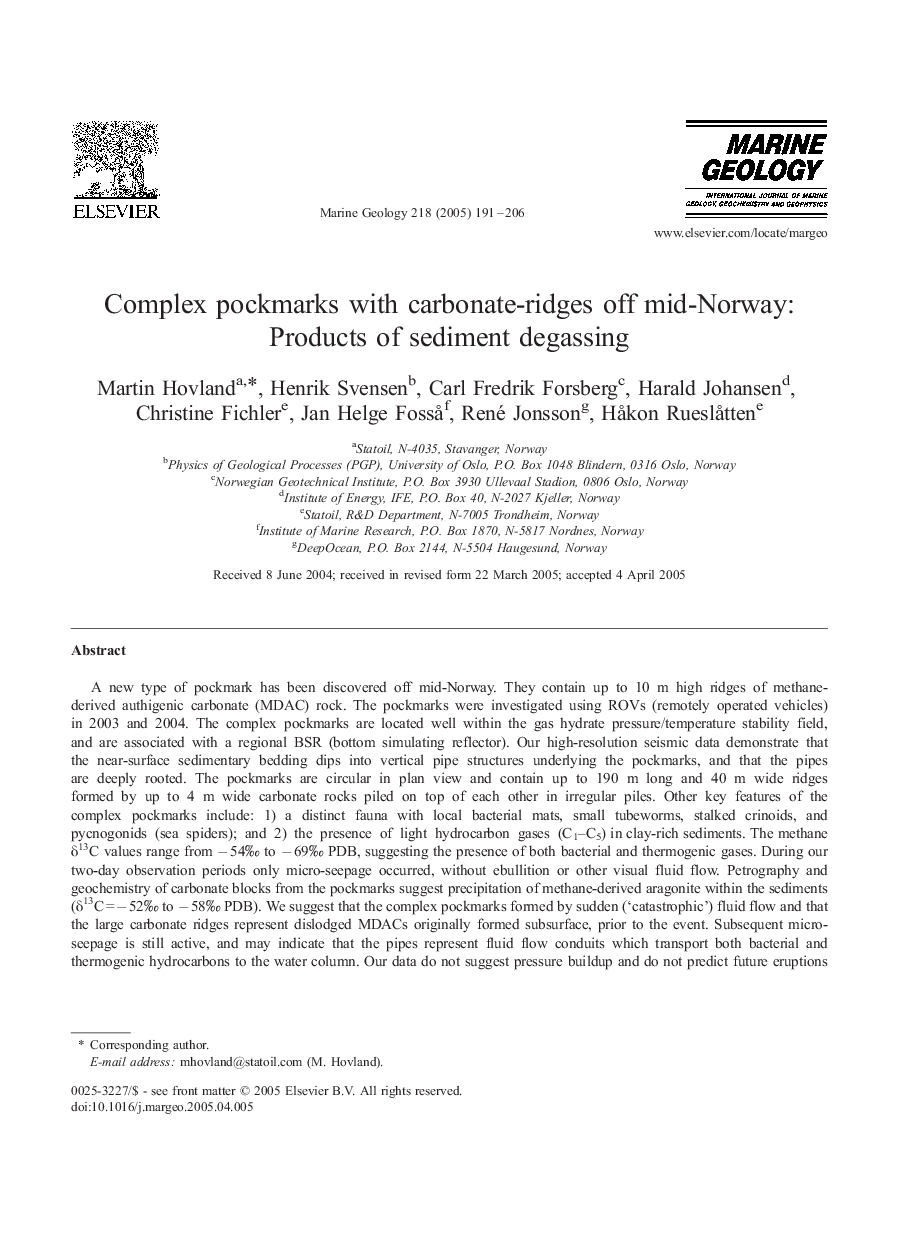| کد مقاله | کد نشریه | سال انتشار | مقاله انگلیسی | نسخه تمام متن |
|---|---|---|---|---|
| 9532645 | 1639224 | 2005 | 16 صفحه PDF | دانلود رایگان |
عنوان انگلیسی مقاله ISI
Complex pockmarks with carbonate-ridges off mid-Norway: Products of sediment degassing
دانلود مقاله + سفارش ترجمه
دانلود مقاله ISI انگلیسی
رایگان برای ایرانیان
کلمات کلیدی
موضوعات مرتبط
مهندسی و علوم پایه
علوم زمین و سیارات
ژئوشیمی و پترولوژی
پیش نمایش صفحه اول مقاله

چکیده انگلیسی
A new type of pockmark has been discovered off mid-Norway. They contain up to 10 m high ridges of methane-derived authigenic carbonate (MDAC) rock. The pockmarks were investigated using ROVs (remotely operated vehicles) in 2003 and 2004. The complex pockmarks are located well within the gas hydrate pressure/temperature stability field, and are associated with a regional BSR (bottom simulating reflector). Our high-resolution seismic data demonstrate that the near-surface sedimentary bedding dips into vertical pipe structures underlying the pockmarks, and that the pipes are deeply rooted. The pockmarks are circular in plan view and contain up to 190 m long and 40 m wide ridges formed by up to 4 m wide carbonate rocks piled on top of each other in irregular piles. Other key features of the complex pockmarks include: 1) a distinct fauna with local bacterial mats, small tubeworms, stalked crinoids, and pycnogonids (sea spiders); and 2) the presence of light hydrocarbon gases (C1-C5) in clay-rich sediments. The methane δ13C values range from â 54â° to â 69â° PDB, suggesting the presence of both bacterial and thermogenic gases. During our two-day observation periods only micro-seepage occurred, without ebullition or other visual fluid flow. Petrography and geochemistry of carbonate blocks from the pockmarks suggest precipitation of methane-derived aragonite within the sediments (δ13C = â 52â° to â 58â° PDB). We suggest that the complex pockmarks formed by sudden ('catastrophic') fluid flow and that the large carbonate ridges represent dislodged MDACs originally formed subsurface, prior to the event. Subsequent micro-seepage is still active, and may indicate that the pipes represent fluid flow conduits which transport both bacterial and thermogenic hydrocarbons to the water column. Our data do not suggest pressure buildup and do not predict future eruptions from the complex pockmarks. Thus our data rather suggest that the 'catastrophic' formation of the complex pockmarks may be a one-time-event.
ناشر
Database: Elsevier - ScienceDirect (ساینس دایرکت)
Journal: Marine Geology - Volume 218, Issues 1â4, 30 June 2005, Pages 191-206
Journal: Marine Geology - Volume 218, Issues 1â4, 30 June 2005, Pages 191-206
نویسندگان
Martin Hovland, Henrik Svensen, Carl Fredrik Forsberg, Harald Johansen, Christine Fichler, Jan Helge FossÃ¥, René Jonsson, HÃ¥kon RueslÃ¥tten,